 | 

























|
Kids and Guinea Pigs --
Fact, Fiction & Fun

| 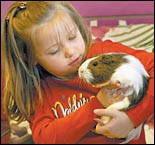 Kids and Guinea Pigs have been synonymous for years and years. Talk to any adult about guinea pigs and frequently you'll hear the story about how they had guinea pigs as kids. More often than not, their story ends in some sad tale of how poorly the guinea pig was kept or some tragic end that it met. Unfortunately, as long as pet stores keep selling animals, the uninformed guinea pig buying parents are still out there today in droves, repeating all of those same mistakes, a hundred times a day, every day. Kids and Guinea Pigs have been synonymous for years and years. Talk to any adult about guinea pigs and frequently you'll hear the story about how they had guinea pigs as kids. More often than not, their story ends in some sad tale of how poorly the guinea pig was kept or some tragic end that it met. Unfortunately, as long as pet stores keep selling animals, the uninformed guinea pig buying parents are still out there today in droves, repeating all of those same mistakes, a hundred times a day, every day.
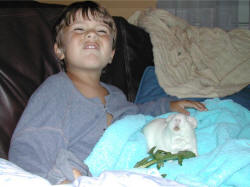 Overwhelmingly, the vast majority of the parental population really do view guinea pigs as TOYS for the younger kids and PROJECTS for the older kids, disposable when the interest wanes. The parents don't think they think that way, but fundamentally, they do. Overwhelmingly, the vast majority of the parental population really do view guinea pigs as TOYS for the younger kids and PROJECTS for the older kids, disposable when the interest wanes. The parents don't think they think that way, but fundamentally, they do.
This page has three objectives: 1) to enlighten those parents who are considering getting their child or children a guinea pig as a pet, and 2) to help those parents who already have guinea pigs with suggestions on teaching young children how to interact safely and respectfully with the animals, and 3) to educate people in general about the importance of making the right decision for the right reasons to adopt animals in the first place.
| |
|
|
The truth is, any guinea pig rescue much prefers to adopt out to adult households with no kids. Why? The social issues associated with kids, parents and 'pocket pets' are the cause of the homeless problem with guinea pigs, rabbits, rats and other small creatures.
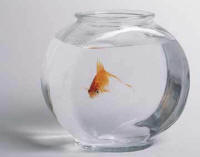 The very unfortunate attitudes that most people have towards animals starts with the early lessons learned in childhood. And that usually starts with the trip to the pet store for a goldfish in a bowl of water that subsequently dies from poor care and/or neglect and is flushed down the toilet. "Oh well, it's only a fish." Then, it's usually back to the store for another fish, or perhaps time to move up to a hamster. A lesson in responsibility that was learned by the fish. (see this link for PROPER goldfish care.) The very unfortunate attitudes that most people have towards animals starts with the early lessons learned in childhood. And that usually starts with the trip to the pet store for a goldfish in a bowl of water that subsequently dies from poor care and/or neglect and is flushed down the toilet. "Oh well, it's only a fish." Then, it's usually back to the store for another fish, or perhaps time to move up to a hamster. A lesson in responsibility that was learned by the fish. (see this link for PROPER goldfish care.)
The absolute last thing any rescue wants to hear is how the 'responsible parent' wants to get a guinea pig to help teach their child responsibility. ANY time we hear that, then we know that it's not the child that needs teaching, it's the parent. Honestly, that's a given 100% of the time.
Even with very stringent adoption criteria and low return rates (people bringing back the guinea pigs they've adopted), rescues experience about a 10 to 1 ratio of returns from families with children as compared to adults-only households. The ratio of actual surrenders, phone calls from people wanting to surrender and ads placed for 'rehoming' is closer to 100 to 1 from families with kids as compared to adults-only households. The problems compound with the parent's attitude of "it's only a guinea pig" combined with the kid's attitude of "I want a guinea pig (read 'new toy')." This recipe creates one highly disposable animal exacerbated by the pet stores that use the guinea pig as a loss leader (cages usually at child's eye level) to encourage the purchase of the cute, little, fuzzy, moving toy so that the parents will become loyal customers of the profit-generating supplies. 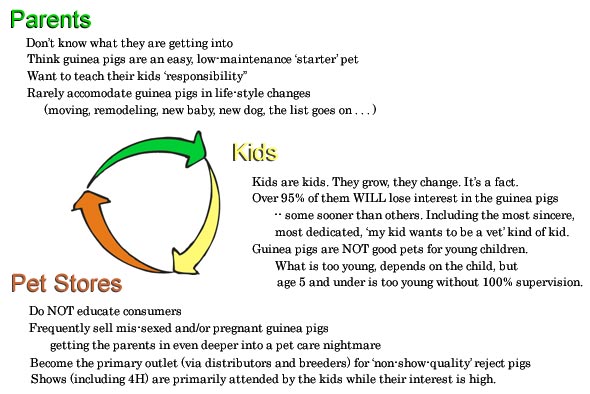
Since we'll NEVER find enough adults-only households for all the homeless guinea pigs put in this vicious cycle, we do everything we can to break the cycle! As a parent, YOU can help break the cycle, too. It starts with the LIFE-LONG lessons that you teach your children about animals BY EXAMPLE. When the kids are bored and no longer want to take care of the guinea pigs, the LAST thing you want to teach them is how one dumps their responsibility on the local shelter or rescue so that the taxpayers can pay for the care and rehoming expense or kill the unwanted animals behind closed doors. Ignorance is bliss. Or expect the too few rescues who are already overburdened in many ways to pick up the cost of care and feeding (sometimes for a long time) and rehoming of your animals out of their personal pockets. It is pretty much guaranteed that your child will lose interest in the guinea pigs. If, and ONLY IF, the guinea pigs are a PART OF FAMILY, do the guinea pigs have a chance at remaining in the home, happy and healthy for duration of their little lives (5-8 years). Break the cycle with solid commitment and education. Educate yourselves and your children. The lessons your children learn about animals can provide them with a great foundation for being caring and strong, yet sensitive adults. Also, it's vitally important to be a ROLE MODEL to your friends and family as well as your children's friends and their families. We need help i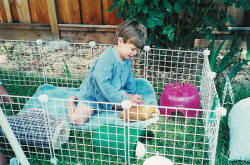 n educating that bigger population and effecting a change in attitude towards animals. That's where you come in. n educating that bigger population and effecting a change in attitude towards animals. That's where you come in.
We receive many phone calls and adoption applications from parents as prospective adopters of guinea pigs. If we can talk a parent OUT of getting guinea pigs for their child or children, then we count that as one very successful phone call and a future surrender that was prevented. If, after discussing all the tough issues and requirements that give many parents heartburn, the parents are still enthusiastically adamant about adopting, then by all means, we enthusiastically continue with them in the education and adoption process. means, we enthusiastically continue with them in the education and adoption process.
Here's the kicker on successful adoptions to homes with children: IF the parents want the guinea pigs (and you must adopt two, not just one) for the child, we WILL NOT ADOPT. Period. End of story. IF the parents want the guinea pigs for the FAMILY or themselves (and they happen to have kids), then odds are much greater that we will adopt out to them. The gray area which are the tough calls are those parents who start out wanting the guinea pigs for their children, who seem to get all the messages, who are enthusiastically willing to do everything right, who you think will grow into loving the animals as much or more than their kids. Sometimes they do. Sometimes they don't. The Ideal AGEIs there an ideal age for a child to be for caring for a guinea pig? We are frequently asked this, and YES, there is. 9 to 11. Of course, it varies child-by-child based on their individual maturity and experience and what not, but 9 to 11 is the ideal age. Why? There are a lot reasons. With younger children, the understanding and ability to read, research and think critically about the animal and their associated actions just isn't there. With younger children, the 'toy' mentality is very much present. Also with younger children (especially 5-6 and under), there is much less dexterity and physical ability to handle and manage various guinea pigs, unintentional accidents are far more prevalent. At age 9, if the guinea pig lives 5 years, the child will be 14, school activities will have increased dramatically and interests will have changed, but they are still a teen and at home. In the mid-to-late teens, a child's life changes dramatically as they move quickly into adulthood. Time for the animals will quickly become non-existent and the cavies move rapidly to the bottom of their list of priorities. Rare is the teen who moves away from home to a living situation where they can and will embrace and afford their guinea pigs. This underscores why it is so important for the guinea pigs to be PART of the FAMILY.
| |
|
Popular NOTIONS which are MYTHS that contribute to the homeless cycle:
 | Guinea pigs are a great STARTER pet because:
 | They are small and don't need much room.
WRONG, wrong, wrong. Why is it so many people think guinea pigs stink? Because they are stuck living in pet store cages which are glorified litter-boxes. If YOU had to eat, sleep and live in your bathroom and couldn't flush the toilet, unless some benevolent dictator mucked out your mess all the time, you would stink, too. Guinea pigs actually need about 3 times the space of the largest pet store cage. 10 1/2 square feet is the recommended cage size. The larger the cage, the easier it is to keep clean. See guineapigcages.com for great info on inexpensive, easy-to-clean, proper guinea pig cages.
And why is it that so many adults think that guinea pigs are boring? You'd turn into a very boring person, too, if you were forced to live out your life in a bathroom. Think about it. Barely enough room to walk, let alone run, play, exercise, explore and if you are the average human equivalent to a guinea pig, then you have NO ONE -- not one other living person to ever talk to the rest of your life. You just sit there, with a broken spirit.
Read through the testimonials on the Guinea Pig Cages site about the radical changes in behavior when guinea pigs are granted a new lease on life in a properly-sized cage. When you see the difference in the animals, you begin to understand that the standard crap (small cage sizes) perpetuated by the pet stores and breeders is pure abuse.
|  | They are EASIER to take care of than a cat or dog.
Ha! No way. The shopping alone is much more work than shopping for any cat or dog. One needs a STEADY and CONSISTENT supply of fresh greens, vegetables and fruits. This usually requires twice a week visits to the grocery store -- without fail. You need to buy special bedding. You need to buy good quality Timothy Hay and good quality guinea pig pellets. Many of these items are NOT available at your average cat or dog pet store. The guinea pigs need to be fed fresh veggies MORNING and EVENING, hay refreshed about 3 times a week, water bottles daily or at least 3 times a week, cage refreshed (partial cleaning) mid-week (minimum) and thoroughly cleaned once a week (minimum). They should have an HOUR a DAY of floor time (minimum). You have to prepare for and clean up after floor time. This is a LOT of work, day after day, week after week, month after month, and year after year. There is NO WAY the average kid stays motivated to continue with this level of effort. It's hard enough for a highly-motivated adult.
|  | We can put the cage on top of the dresser in the kid's bedroom.
Not! This is has become one of the key gating criteria on adoption from Cavy Spirit. We absolutely, unequivocally NEVER allow cages to be kept in a child's bedroom. The very few exceptions that we've made, turned out to be big mistakes in the long run. There are other good reasons, which are all spelled out on this page, but bottom line, a cage in the kid's bedroom makes it the kid's pet and NOT a family pet. That's just the way it is and that is NOT acceptable.
|
|  | We can TEACH the child responsibility with feeding and cleaning chores.
No. Not at the expense of the animal. It doesn't take a degree in child psychology to come up with more sane ways to teach children responsibility. Any 'mistake made' by the child means a 'price paid' by the animal. Also, see this link for more information.
|  | We'll get one healthy, non-pregnant female or male from the pet store.
This is a JOKE! And the joke would be on you. Do yourself a favor and stay OUT of the pet stores. See this page for more information on pet stores. You should ADOPT two, non-breeding guinea pigs. You must make absolutely certain of the sex. Contact rescues, shelters or private parties to adopt. Do NOT buy an animal at a pet store or from a breeder. |
| |
| |
Suggestions from various people on how to help kids interact with guinea pigs (pulled with permission, primarily from this thread).
We have a rule that kids have to be sitting and that the pig has to be in a cozy. I use this up to 12-year-olds and sometimes older.
I have found that kids sometimes panic at the nails. Having the piggy secure in the cozy sack seems to help the comfort level of both the child and the pig. We use the sitting rule so that no one gets accidentally dropped.
from Julian | My daughter is just turning five and is really great with all our animals, especially our pigs. I do have rules to keep my piggy babies safe.
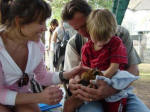 She is not allowed to get them out of the cage or put them back, she cannot feed them without asking, and her least favorite she cannot walk around while holding them (mommy can, so it makes her jealous). She is not allowed to get them out of the cage or put them back, she cannot feed them without asking, and her least favorite she cannot walk around while holding them (mommy can, so it makes her jealous).
But this is my kid. Other kids, even my beloved nephew, is a different story. I trust him to sit and hold them on the couch, or sit on the floor and play. That is pretty much it.
from butterflyturtles | I have a 6-year-old and a 3-year-old . . .
But we've had guinea pigs for 4 years now. What I've found is that they relate to a story or some kind of a play if you make it fun and descriptive and paint it with words.
I told my two children to 'close your eyes' and picture yourselves playing at the park. You are having fun and swinging. I described the day and all.  They'd peek and open their eyes when they started getting into the story. Then I talked about a huge PURPLE MONSTER approaching. He was BIGGER then the trees! He had teeth, all pointy, when he 'smiled.' And when he talked, it was loud like booming thunder. But he sat across the street and simply watched them play. At first, I asked "you would feel startled, wouldn't you?" They'd peek and open their eyes when they started getting into the story. Then I talked about a huge PURPLE MONSTER approaching. He was BIGGER then the trees! He had teeth, all pointy, when he 'smiled.' And when he talked, it was loud like booming thunder. But he sat across the street and simply watched them play. At first, I asked "you would feel startled, wouldn't you?"
 They both nodded their heads. "But, when you find out, even though he is big, he is also kind and gentle and doesn't want to hurt you. His fur is pretty and thick and looked soft." They both smiled. "But as you walk closer, he holds out his big paw for you to pet. Would you touch him if he was a nice monster?" They both nodded their heads. "But, when you find out, even though he is big, he is also kind and gentle and doesn't want to hurt you. His fur is pretty and thick and looked soft." They both smiled. "But as you walk closer, he holds out his big paw for you to pet. Would you touch him if he was a nice monster?"
They both agreed they would. . . Then I said, "What if the monster got very excited about you getting closer to him . . . so excited that he reached out to grab you!" and I even made my own voice go a bit growly when I asked them the question.
They both jumped a bit -- eyes wide. They laughed because I made my monster face. But the point was made when I said, "See? The guinea pigs feel the same way. They would love for you to pet and love them, but, just like the purple monster, you have to be very still and let them come to you. You don't want to frighten your new friends away."
Anyway, it worked. They are both are very gentle and sit down outside the 'play area', waiting for the piggies to approach, one-by-one, in their own time. Although, sometimes the guinea pigs need to be bribed with a bit of lettuce.Oh! Here's a bit of a hint, too.
Do not tell the story just once. Whenever the situation arises again, ask them, "Do you remember the Purple Monster?" If they tell you they do (and their little faces light up with recognition), you may test them a bit and ask THEM to tell you the story. They'll get bits and pieces of it. You can fill in the rest. Then ask again, "You don't want to be like the purple monster and frighten your friends away. Right? So let's remember to be very still and let the guinea pigs come to us, first."
It's a good story to tell when the smaller children are exposed to any timid animal. |
My kids will sit on the floor 'toe-to-toe' and create a 'pin' with their legs. They usually roll Dragon's bell toy around so he can chase it. He loves it so much.
Here's another game we love to play. It's called "Tunnel Trouble!"
What I normally do during floor time, is put down a few cardboard boxes around the play area. This is very important to new pigs who are still feeling a bit shy, but need floor time (alone, though, until they can safely be introduced to the rest of the herd). The boxes have two openings -- like a tunnel. When the piggy goes in, the child who is trying to win the new little guy's trust will lay on his or her belly, at least a full arm and a half length away. They hold a nice treat (lettuce or carrot or bit of apple) and gently speak to him to coax him back out of the tunnel. This is usually only for the very patient older child. But you should see the pride when we all celebrate a nose peeking out of the tunnel, and even more when the piggy takes the morsel of food from the child's hand!
from L.M.One | 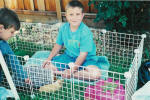 I think the most important rule is to have them sitting on the floor so the cavy can come to them and to always supervise. Even a well-meaning child can cause harm. I have rabbits and this works well with them. If they want to escape from my 4 year old they can. My son inadvertently touched one of my degu's tails and the tip came off with a lot of blood! Since then he is only allowed to watch them. I also teach Fourth Grade, but I wouldn't trust many of them with anything smaller than a dog. I think the most important rule is to have them sitting on the floor so the cavy can come to them and to always supervise. Even a well-meaning child can cause harm. I have rabbits and this works well with them. If they want to escape from my 4 year old they can. My son inadvertently touched one of my degu's tails and the tip came off with a lot of blood! Since then he is only allowed to watch them. I also teach Fourth Grade, but I wouldn't trust many of them with anything smaller than a dog.
from Joanna | I started my niece and nephew off with guided petting, where I held their hands and controlled how they were petting the pigs. "Pet him softly . . . let's stay away from his eyes . . . " etc. Then they moved on to petting with supervision, learning more about the pigs, "What color is Einstein's nose?" "PINK!" My niece has held pigs in her lap with me sitting right beside her and is at the point where she can hold some of the pigs (mainly Cuddles and Doom) in her lap on her own. Cuddles is quite fond of her and Doom is pretty easy to manage as long as he's getting attention and being talked to. I don't let her hold Suzi, who is high-strung and somewhat bitey, or Jackie, who is terrified of everything, yet.
My niece is almost 6 and my nephew is almost 3, and has started learning how to give chin-scratches to Jackie.
I also started them out fairly young getting treats for the pigs. Baby carrots and grape tomatoes are their favorites, and they'll argue over whose carrot Jackie is eating more of. They started out just putting the carrots or tomatoes in front of the pigs (in my lap or on a towel on the floor) but moved on to holding the carrot while the pig chews it. With multiple pigs, they're scrupulously fair, although sometimes overzealous in saying, "No, Cuddles, that's Suzi's tomato, yours is this one," which the pigs ignore. My niece and nephew are both very much into making sure all the pigs have tomatoes or carrots and nobody is left out, which is good. This is probably a good way to show that there are enough tomatoes for everyone and sharing is a good thing, etc.
from salana | 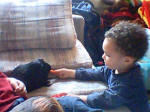 I have a 4-year-old and a 2-year-old. My four old son, Toby is allowed to hold one piggie at a time in his lap and feed them veggies. Toby's really good with the piggies, the cat, and the fish. I have a 4-year-old and a 2-year-old. My four old son, Toby is allowed to hold one piggie at a time in his lap and feed them veggies. Toby's really good with the piggies, the cat, and the fish. 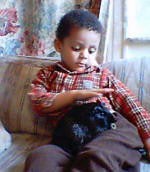 Toby even lets Rayna climb up on his chest for a kiss while he's sitting on the couch. Toby even lets Rayna climb up on his chest for a kiss while he's sitting on the couch.
My two-year-old son, Max is a completely different story. Max is allowed to feed veggies to a pig that is either on my lap or on the couch while he sits on the floor. This way if Max gets bored and wants to get up to play then no piggie gets accidentally smushed, dropped, or hurt. I or my husband closely supervise all piggie time with the kids and we don't have more than 2 pigs out at a time. We also don't do floor time with the pigs until the kids are asleep.
My boys also argue over who is eating more veggies from them too. It's also cute to see Max try to bribe a pig to leave Toby's lap for him.
from momof911kids |
| |
| |  |

